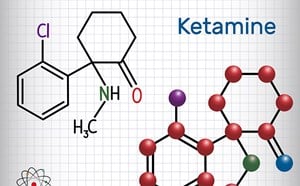
Lidocaine
Lidocaine as an opiate sparing analgesic: In an unblinded study of 32 patients with undifferentiated pain who received 1.5 mg/kg of IV lidocaine over 10 minutes then randomized to receive the same dose of lidocaine infused over 50 minutes or IV morphine, the lidocaine group had similar satisfaction scores (87% lidocaine v 88% morphine) and fewer side effects (13% v. 38% in morphine group). [Clattenberg, et al. Pain Med 2018].
Alternatively, IV lidocaine may be infused without a loading dose at a rate of 1 mg/kg/h titrated in 0.25-0.5mg/kg/h increments based on response and signs of toxicity with a maximum rate of 2mg/kg/h. Caution is advised in patient with heart block, heart failure, history of seizures, and lower doses should be used in patients with hepatic and renal dysfunction. First signs of toxicity include tongue numbness, metallic taste, and tinnitus.
In a study of 15 adult patients with acute sickle cell crisis using the rates described above, there was a mean reduction in morphine dose equivalents by 32% 24 hours after initiation of infusion. Average duration of infusion was 4.4 days, so this may be an option in patients who typically get admitted for crises. [Nguyen, et al. J Pain Palliat Care, Pharmacotherap 2015]..
In 26 pediatric (10-19y) status migrainous patients in the PICU setting who received IV lidocaine bolus (2.9 mg/kg) and infusion (1-1.5 mg/kg/hr), pain scores achieved 50% reduction in a mean of 16 hours and complete resolution at a mean 19h (range 0.8-72h). [Ayulo, et al. Pediatr Crit Care 2018].
Iranian study of 120 patients with renal colic receiving 1.5mg/kg IV lidocaine v 0.1mg/kg morphine for renal colic showed statistically significant improvement in pain scores at 5 minutes with resolution, defined as pain score of 3 or less for 30 minutes, being achieved in 90% of the lidocaine group and 70% in the morphine group. [Soleimanpour, et al. BMC Urology 2012].
40 patients with critical limb ischemia receiving IV lidocaine 2mg/kg had a statistically significant decrease in pain scores at 15 and 30 minutes compare to those who received 0.1mg/kg morphine. [Vahidi, et al. Emerg Med J July 2015]
Nasal lidocaine for sphenopalatine ganglion block has been described with variable statistical results. One method is to soak long cotton swabs in 4% lidocaine and, with the patient supine, advancing the tips into the nasopharynx until resistance is met and instilling for 10 minutes. Alternatively, 0.5mL of 4% or 2 mL of 2% may be atomized into the nares. An Iranian study of 90 patients 14y and older, showed significant pain score reductions after one puff of 10% lidocaine, with pain reduction as early as 1-minute post instillation. [Mohammadkarimi, et al. J Res Med Sci 2014 Apr].
In a comparison of arterial lidocaine plasma concentration after atomized v tracheal lidocaine, atomized lidocaine showed larger peak plasma concentrations suggesting improved bioavailability with atomization compared to endotracheal instillation. AHA recommends ET doses at 2-2.5 times the IV dose. Theorized mechanism is the increased surface area of particles after atomization. [Takaenoki, et al. Anesth Analg 2016 Jul].
Nebulized lidocaine has shown a mixture of results for cough, asthma and COPD. In 127 COPD patients, receiving INH lidocaine or terbutaline showed similar reductions in cough [Chong, et al. Emerg Med J 2005]. 50 asthmatics receiving either 100mg of INH lidocaine QID showed statistical improvement in FEV1, symptoms and decreased bronchodilator use compared to nebulized saline [Hunt, et al. J Allergy Clin Immun 2004]. 5mL of 4% lidocaine may be used up to three times before toxic level achieved. [Hayes. ALiEM 2013 Aug].
Nicholas Mota, DO
Associate Newsletter Editor


